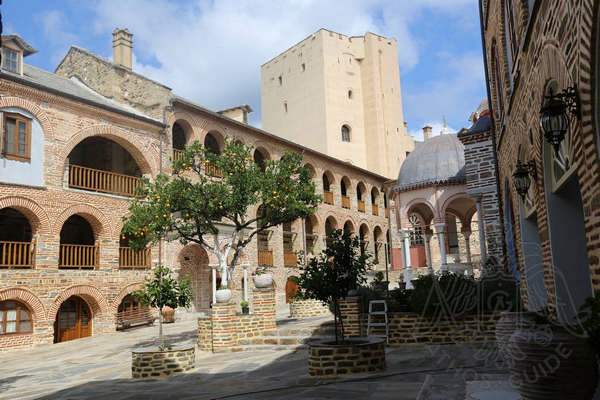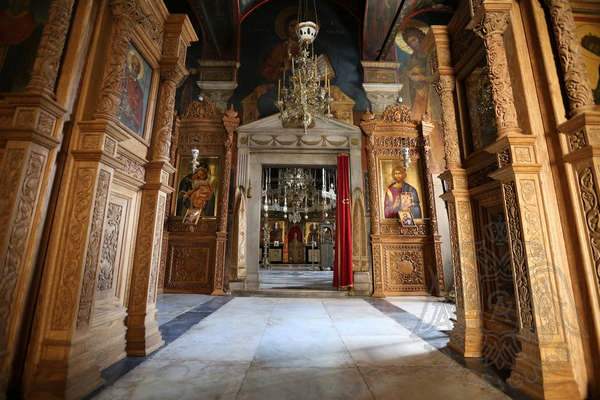History and present days
The Monastery of Pantokratoros stands on a rocky peninsula in the middle of the bay, which starts at Cape Chalkias to the north and ends at Cape Paparapis to the south. Regarding the view and the location of the monastery, there is a striking resemblance to the nearby Monastery of Stavronikita, which is further emphasized by the presence of an arched aqueduct. However, due to the shape of the terrain, the proximity to the sea is much more intense.
“The sacred and venerable Monastery of Pantokratoros is really beautiful, as it is situated in a fine location close to the sea, surrounded by a strong castle.” (Ioannis Komnenos, 1701)
.jpg)
Many travelers have vividly described the storms and the wild sea that unfolds before the monastery. On the southern side of the rocky peninsula there lies a small fortified harbor, the only one existing on the eastern coast, after the one of Great Lavra. The presence of this sheltered bay may explain the existence of the ancient settlement of Thyssos, which was located in the same spot and was completely destroyed by an earthquake in the 5th century BC.
The layout of the monastic structure has an irregular shape. The original architectural complex (14th century) was limited to the present-day western section of the monastery, while an expansion took place during the 16th century. The new construction takes full advantage of the terrain. The steep ground and the rocks to the east serve for defensive purposes, while the more accessible western side accommodates the living spaces. The wings of the monastery were shaped during various construction phases and after a sequence of renovations. Until the mid-18th century, the monastery was divided into two sections by a wing that no longer exists. However, we know its presence since it has been illustrated in a drawing by Barsky (1744). The northern wing was renovated in 1781 and again in 1999 to meet the needs that arose from the monastery’s turn to the cenobitic system. The western wing, which houses the trapeza and the two towers, was restored in 1774 by a certain Triantaphyllos, who was proclaimed the "new founder." Some of the monks’ cells in the northern and western wings consist of two rooms, as it used to be when the monastery followed the idiorrhythmic system. The eastern wing (16th century) was destroyed by fire in 1948 and rebuilt in 1970.
Regarding the defensive tower, it was facing serious humidity problems. Several interventions managed to successfully resolve the moisture issues, though they drastically altered the tower’s appearance, disrupting its architectural coherence with the surrounding structures.
History
Tradition attributes the founding of the monastery to the Emperor Alexios I Komnenos, dating its establishment to his reign (1081–1118).
Documents confirm the existence of the monastery between 1283 and 1328. Written records mention as founders the brothers Alexios and Ioannis, high-ranking military officers, who participated in military campaigns against the Serbs and the Ottomans in the regions of the Strymon Valley, Kavala, and Thasos. In 1357, the Emperor John V granted them those territories through a chrysobull. One of their notable works was the tower of Marmarion in Amphipolis.
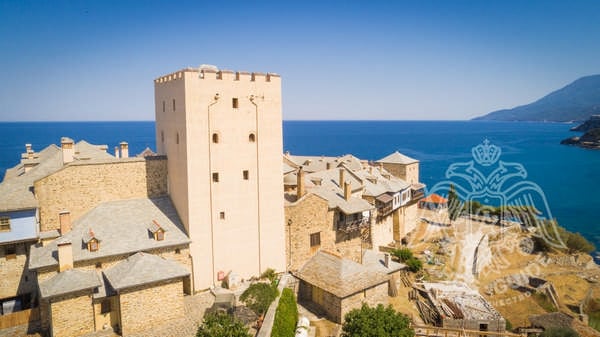
The two brothers rebuilt the monastery from its foundations. Six ancient monastic dependencies were in total added to the Pantokratoros community. Alexios passed away in 1368/9, so that Ioannis continued both the construction work and the administration of the region. He fortified the Limenas of Thasos while, between 1371 and 1373, he defeated the Ottoman pirates who had attacked Mount Athos. His donations to the monastery, including a large metochion on Lemnos, were ratified by a golden bull of the Emperor John V Palaiologos. Ioannis is depicted in a portable icon (1360–70), donated to the monastery and housed in the Hermitage Museum in Saint Petersburg. In 1357, Ioannis married Anna Asanina, the niece of the Empress Helen, daughter of John VI Kantakouzenos and Irene Andronikos Asan. By 1384, Ioannis had retired to the Monastery of Pantokratoros, where he took the great and angelic schema under the name Ioannikios. The tomb of the founders is located in the katholikon of the monastery.
The monastery is dedicated to the Transfiguration of the Savior and was inaugurated shortly before the passing of the Ecumenical Patriarch Callistus I (†1363). By his sigillion, it was recognized as "Patriarchal.” It was also designated as "Imperial," possibly before 1367. During the Ottoman period, the monastery faced serious financial difficulties. However, it managed to recover and expand during the 16th century, thanks to the generous donations of the Voivode of Wallachia, Neagoe Basarab (1512–1521), and the Grand Logothete of Moldavia, Gabriel Tortusanu. Additional support was provided by the Empress Catherine the Great (1762), who permitted a fundraising campaign for the monastery within the Russian Empire. The monastery suffered extensive damage from fires in 1773 and 1948. Today, it holds the seventh position in the hierarchy of Mount Athos monasteries. In 1992, a group of monks from the Monastery of Xenophontos, led by the Archimandrite Visarion (†2001), repopulated the monastery, restoring its cenobitic system by a decree of the Ecumenical Patriarch Bartholomew I. It was the last Athonite monastery to revert to the cenobitic status.
Saint Callistus II Xanthopoulos (†1397), Ecumenical Patriarch of Constantinople, resided in the Monastery of Pantokratoros for extended or brief periods. He also lived as an ascetic at the Hermitage of Saint Onuphrius. Saint Gregory Palamas (1296–1359), Metropolitan of Thessaloniki, also spent a short time living as an ascetic in the monastery’s surroundings.
In the 16th century, Saint Theonas, Metropolitan of Thessaloniki, resided at the Hermitage of Saint Onuphrius, which was subsequently named after him. Saint Theophilos the Myrrh-Gusher (†1548) lived as an ascetic in the Cell of Saint Basil in Kapsala. According to tradition, Saint Gerasimos of Kefalonia (16th century) also practiced asceticism in Kapsala. Saint Joseph, Metropolitan of Timișoara, Romania (†1656), lived in the monastery, as did Saint Nicodemus of the Holy Mountain as well. He was accompanied by Saint Makarios Notaras. Saint Paisius Velichkovsky practiced asceticism in the Skete of Prophet Elijah. The monastery was home to many erudite monks, including Monk Kallinikos (1821–1884), who translated the work of Abba Isaac the Syrian, and Theophanes (early 19th century), who authored significant works on Byzantine music theory.
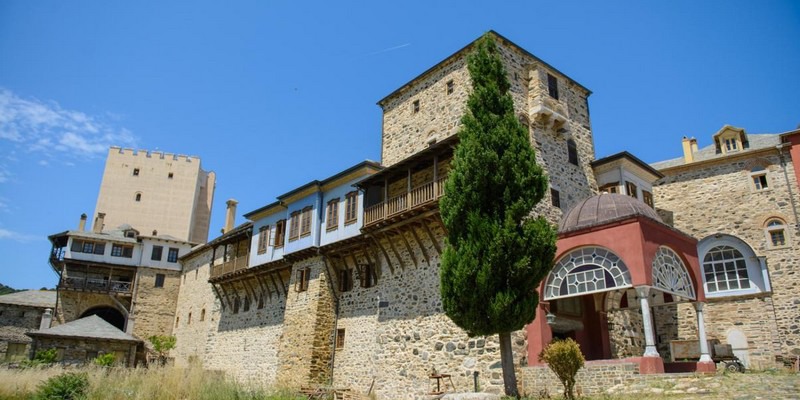
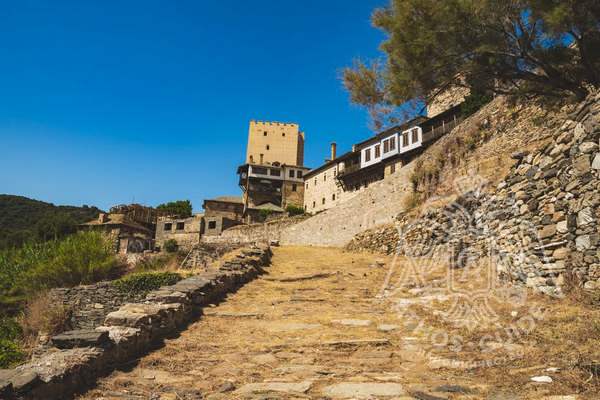 The entrance to the monastery is located at its southwestern corner. It is decorated with a depiction of Christ the Almighty. Opposite the entrance there stands a kiosk, which offers an exceptional view of the eastern coastline. Further along are the arsanas and the Chrysoraris stream. To the right of the entrance, there is a marble fountain (1781) adorned with great motifs, characteristic of the Rococo style. Above the fountain, one can see the fresco with the Transfiguration of the Savior.
The entrance to the monastery is located at its southwestern corner. It is decorated with a depiction of Christ the Almighty. Opposite the entrance there stands a kiosk, which offers an exceptional view of the eastern coastline. Further along are the arsanas and the Chrysoraris stream. To the right of the entrance, there is a marble fountain (1781) adorned with great motifs, characteristic of the Rococo style. Above the fountain, one can see the fresco with the Transfiguration of the Savior..jpg)
 Outside the monastery, on a steep cliff to the southeast, stands the Chapel of
Outside the monastery, on a steep cliff to the southeast, stands the Chapel of 